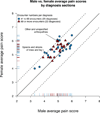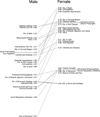Sex differences in reported pain across 11,000 patients captured in electronic medical records
- PMID: 22245360
- PMCID: PMC3293998
- DOI: 10.1016/j.jpain.2011.11.002
Sex differences in reported pain across 11,000 patients captured in electronic medical records
Abstract
Clinically recorded pain scores are abundant in patient health records but are rarely used in research. The use of this information could help improve clinical outcomes. For example, a recent report by the Institute of Medicine stated that ineffective use of clinical information contributes to undertreatment of patient subpopulations--especially women. This study used diagnosis-associated pain scores from a large hospital database to document sex differences in reported pain. We used de-identified electronic medical records from Stanford Hospital and Clinics for more than 72,000 patients. Each record contained at least 1 disease-associated pain score. We found over 160,000 pain scores in more than 250 primary diagnoses, and analyzed differences in disease-specific pain reported by men and women. After filtering for diagnoses with minimum encounter numbers, we found diagnosis-specific sex differences in reported pain. The most significant differences occurred in patients with disorders of the musculoskeletal, circulatory, respiratory and digestive systems, followed by infectious diseases, and injury and poisoning. We also discovered sex-specific differences in pain intensity in previously unreported diseases, including disorders of the cervical region, and acute sinusitis (P = .01, .017, respectively). Pain scores were collected during hospital encounters. No information about the use of pre-encounter over-the-counter medications was available. To our knowledge, this is the largest data-driven study documenting sex differences of disease-associated pain. It highlights the utility of electronic medical record data to corroborate and expand on results of smaller clinical studies. Our findings emphasize the need for future research examining the mechanisms underlying differences in pain.
Perspective: This article highlights the potential of electronic medical records to conduct large-scale pain studies. Our results are consistent with previous studies reporting pain differences between sexes and also suggest that clinicians should pay increased attention to this idea.
Copyright © 2012 American Pain Society. All rights reserved.
Conflict of interest statement
Figures


Similar articles
-
Using electronic medical record data to characterize the level of medication use by age-groups in a network of primary care clinics.J Prim Care Community Health. 2013 Oct;4(4):286-93. doi: 10.1177/2150131913495243. Epub 2013 Jul 8. J Prim Care Community Health. 2013. PMID: 24327665
-
Documentation and coding of ED patient encounters: an evaluation of the accuracy of an electronic medical record.Am J Emerg Med. 2006 Oct;24(6):664-78. doi: 10.1016/j.ajem.2006.02.005. Am J Emerg Med. 2006. PMID: 16984834
-
Illustrating the patient journey through the care continuum: Leveraging structured primary care electronic medical record (EMR) data in Ontario, Canada using chronic obstructive pulmonary disease as a case study.Int J Med Inform. 2020 Aug;140:104159. doi: 10.1016/j.ijmedinf.2020.104159. Epub 2020 May 19. Int J Med Inform. 2020. PMID: 32473567
-
Predicting chronic pain after major traumatic injury.Scand J Pain. 2019 Jul 26;19(3):453-464. doi: 10.1515/sjpain-2019-0040. Scand J Pain. 2019. PMID: 31116704
-
Assessment of Patient Medication Adherence, Medical Record Accuracy, and Medication Blood Concentrations for Prescription and Over-the-Counter Medications.JAMA Netw Open. 2018 Nov 2;1(7):e184196. doi: 10.1001/jamanetworkopen.2018.4196. JAMA Netw Open. 2018. PMID: 30646345 Free PMC article.
Cited by
-
Does sex affect the efficacy of systemic pharmacological treatments of pain in knee osteoarthritis? A systematic review.Osteoarthr Cartil Open. 2024 Feb 10;6(1):100438. doi: 10.1016/j.ocarto.2024.100438. eCollection 2024 Mar. Osteoarthr Cartil Open. 2024. PMID: 38375468 Free PMC article. Review.
-
Factors Affecting Health-Related Quality of Life in Multimorbidity.Healthcare (Basel). 2021 Mar 16;9(3):334. doi: 10.3390/healthcare9030334. Healthcare (Basel). 2021. PMID: 33809631 Free PMC article.
-
The Problem of Pain in Rheumatology: Variations in Case Definitions Derived From Chronic Pain Phenotyping Algorithms Using Electronic Health Records.J Rheumatol. 2024 Mar 1;51(3):297-304. doi: 10.3899/jrheum.2023-0416. J Rheumatol. 2024. PMID: 38101917 Free PMC article.
-
Sex differences in pain along the neuraxis.Neuropharmacology. 2022 Jun 1;210:109030. doi: 10.1016/j.neuropharm.2022.109030. Epub 2022 Mar 21. Neuropharmacology. 2022. PMID: 35331712 Free PMC article. Review.
-
Quality of life improvement in aged patients after toenail surgery.Z Gerontol Geriatr. 2019 Dec;52(8):789-794. doi: 10.1007/s00391-019-01504-8. Epub 2019 Feb 1. Z Gerontol Geriatr. 2019. PMID: 30710168 Review. English.
References
-
- Bellamy N, Buchanan WW, Goldsmith CH, Campbell J, Stitt LW. Validation study of WOMAC: a health status instrument for measuring clinically important patient relevant outcomes to antirheumatic drug therapy in patients with osteoarthritis of the hip or knee. The Journal of rheumatology. 1988;15:1833–1840. - PubMed
-
- Benjamini Y, Hochberg Y. Controlling the false discovery rate - a practical and powerful approach to multiple testing. Journal Of The Royal Statistical Society Series B-Methodological. 1995;57:289–300.
-
- Bingefors K, Isacson D. Epidemiology, co-morbidity, and impact on health-related quality of life of self-reported headache and musculoskeletal pain--a gender perspective. European journal of pain. 2004;8:435–450. - PubMed
-
- Cohen J. Statistical Power Analysis for the Behavioral Sciences. 2nd Edition. Lawrence Erlbaum Associates; 1988.
Publication types
MeSH terms
Grants and funding
LinkOut - more resources
Full Text Sources
Other Literature Sources
Medical

